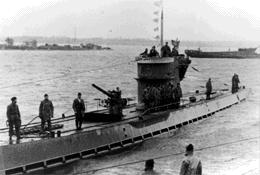

|

|
Home » U-Boat Personalities
U-Boat Aces

During World War Two, Germany launched over 1,000 U-boats into combat against the Allies. Prowling the Atlantic Ocean, these U-boats waged a commerce war which nearly choked the shipping lanes of Great Britain. Together, they sent over 2,900 ships and over 14 million tons of allied shipping to the bottom.
Presented here are among the most incredulous commanders of the High Seas, which fought for control of the shipping lanes of the Atlantic against overwhelming odds, earning the respect of not only from the Axis, but from their bitterest foes as well. In the end, many of these heroic figures met death, in their grim iron coffins, as harsh as they had dealt them.
 |
 |
| The commander of a Type VII peers through the periscope. This photo was widely distributed as propaganda during the war and even appeared on postage stamps. |
The "Edelweiss Boat", U-124 returns to its French port with victory pennants flying. Each pennant represents a ship sunk together with its tonnage. |
The U-Boat Aces
 |
Otto Kretschmer, 1912 – 1998 (Fregattenkapitan)
Sank 44 ships, 262,203 grt
Commanded: U23, U-99
Highest scoring ace, Otto Kretschmer, or the “tonnage king” caused more destruction on the high seas than any other submarine commander to this date. An aggressive commander, his strategy was to attack at night, on the surface and under cover of darkness. His last patrol scored him ten ships, before he was captured. After the war, Kretschmer became a rear admiral in the Federal German Navy and Chief of Staff of the NATO command.
|
|

|
Wolfgang Luth, 1913 – 1945 (Kapitan zur See)
Sank 47 ships, 226,671 grt
Commanded: U-9, U-138, U-43, U-181
A most outstanding commander, Wolfgang Luth was one of the highest decorated officers to be awarded with the Knight’s Cross with Oak Leaves, Swords and Diamonds. Four days after Germany’s surrender, a German sentry guard fired a single warning shot that killed Wolfgang Luth, after he had failed to provide the access code. After the war, Donitz stated that Luth had been chosen to succeed him as Commander of the U-boat force, but the mishap took place before the news was out.
|
|

|
Gunther Prien, 1908 – 1941 (Korvettenkapitan)
Sank 33 ships, 197,218 grt
Commanded: U-47
The Bull of Scapa Flow, he became a celebrity skipper after sinking the British battleship HMS Royal Oak in the heavily defended port of Scapa Flow. He won accolades not only from within Germany, but Churchill himself wrote about his outstanding feat of arms. Quick tempered and staunch, his loss in 1941 caused the nation to mourn. It was not entirely clear how his boat was sunk, as reports suggest he was either depth charged by a British destroyer, or fell victim to one of his own mines.
|
|

|
Erich Topp, 1914 – 2005 (Fregattenkapitan)
Sank 35 ships, 192,601 grt
Commanded: U-57, U-552, U-2513
Commander of the famed "Red Devil" boat, Erich Topp in U-552 scored most of its successes on the Atlantic and American coast. He was also one of the only two commanders to have taken a Type XXI into combat. After the war, he built a successful architectural career before rejoining the Navy in 1958. He had also served as a Military Committee member of the NATO forces.
|
|

|
Heinrich Lehmann-Willenbrock, 1911 – 1986 (Fregattenkapitan)
Sank 25 ships, 183,223 grt
Commanded: U-5, U-96
|
|

|
Herbert Schultze, 1909 – 1987 (Korvettenkapitan)
Sank 27 ships, 174,475 grt
Commanded: U-48
Schultz was the first to reach the 100,000 tons sank and the second (after Prien) to receive the Knight’s Cross. He was known for his generosity and had on one occasion radioed London to request the British to send a ship to pick up survivors of his attack.
|
|

|
Heinrich Bleichrodt, 1909 – 1977 (Korvettenkapitan)
Sank 28 ships, 162,171 grt
Commanded: U-48, U67, U-109
Having been a distinguished officer, Bleichrodt broke down at sea on December 26 1943 and requested an immediate return to port. BdU denied his request but on Decemer 31 1943, he insisted and handed command to his 1WO who took U-109 back to St. Nazaire. He was later transferred to a training job where he was promoted in July 1944 and given commaned of the 22nd U-boat Flotilla at Gdynia.
|
|

|
Joachim Schepke, 1912 – 1941 (Kapitanleutnant)
Sank 37 ships, 155,882 grt
Commanded: U-100
One of Germany’s three most celebrated ace, Schepke fell when U-100 was rammed by the British destroyer HMS Vanoc. He was said to have been crushed on the bridge and his last words uttered were reassurances to his crew.
|
|

|
Carl Emmermann, 1918 – 1990 (Korvettenkapitan)
Sank 27 ships, 152,904 grt
Commanded: U-172
Surviving the war, he later returned to Germany, studied engineering and prospered in business.
|
|

|
Johannes Mohr, 1916 – 1943 (Korvettenkapitan)
Sank 29 ships, 135,067 grt
Commanded: U-124
U-124 was attacked and sank with all hands on board on April 3, 1943 off Gibraltar.
|
|

|
Reinhardt Hardegen, 1913 – (Korvettenkapitan)
Sank 23 ships, 119,408 grt
Commanded: U-147, U-123
Hardegen was one of the first five U-boats to participate in the opening moves against the US in what was known as Operation Paukenschlag (Drumbeat). After the war, he was a successful entrepreneur and became a member of Parliament in his hometown.
|
|

|
Gunther Hessler, 1909 – 1986 (Fregattenkapitan)
Sank 20 ships, 113,462 grt
Commanded: U-107
Married to Donitz’s daughter, Ursula, he was a deadly torpedo marksmen, capable of sinking a ship with one torpedo. He holds the record for the most successful war patrol, covering 22,000 miles in 135 days, and sinking fourteen ships.
|
|

|
Klaus Scholtz, 1909 – 1987 (Fregattenkapitan)
Sank 24 ships, 111,546 grt
Commanded: U-108
Scholtz was CO of the German U-boat flotilla in Bordeaux when the war ended.
|
|

|
Fritz-Julius Lemp, 1913 – 1941 (Kapitanleutnant)
Sank 20 ships, 95,507 grt
Commanded: U-30, U-110
Lemp fired the first torpedo of World War Two by sinking the passenger liner Athenia on September 3, 1939. Twenty one months later, he lost the Enigma machine aboard U-110 to the enemy. He was shot by the British raiding party while trying to scuttle the boat.
|
|

|
Hans-Diedrich Freiherr von Tiesenhausen, 1913 – 2000 (Kapitanleutnant)
Sank 2 ships, 40,235 grt
Commanded: U-331
From an aristocracy family, Hans-Diedrich held the title von (=knight). He torpedoed and sank the British battleship Barham in November 1941. U-331 was sank twelve months later, but he survived and was sent to a POW camp.
|
|

|
Peter Erich Cremer, 1911 – 1992 (Korvettenkapitän)
Sank 7 ships, 32,724 grt
Commanded: U-152, U-333, U-2519
Cremer had on several occassions successfully brought the U-333 back to port despite sustaining serious damage, including a ramming attack in the Biscay Bay in 1942. He was also one of the few who had commanded the revolutionary Type XXI Elektroboat. During the last days of the war, U-boat crews were handed with Panzerfausts (bazooka) and told to stop Allied tanks. Cremer was the Naval Anti-Tank Commander.
|
|

|
Albrecht Brandi, 1914 – 1966 (Fregattenkapitan)
Sank 12 ships, 31,689 grt
Commanded: U-617, U-380, U-967
Brandi was one of the most highly decorated officer in the Kriegsmarine, only he and Wolfgang Luth received the Knight’s Cross of the Iron Cross with Oak Leaves, Swords and Diamonds, the highest order of decoration during the war. Brandi gave much of the credit to his crew, and was quoted as saying “The commander wears his medals for the crew”.
|
|

|
Werner Hartenstein, 1908 – 1943 (Korvettenkapitan)
Sank 20 ships, 97,504 grt
Commanded: U-156
Hartenstein's memory lives on to this day for his remarkable feat during his rescue of the survivors of his torpedo attack in the Laconia Incident. Many have revered him as a friend and a gentleman. His boat was sunk with all hands on her fifth patrol in March 1943.
|
|
|






























